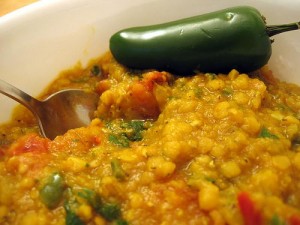Here is the way I get excited over cooking: when I’m at the intersection of great taste, great thrift, healthiness and low carbon impact. I also need my cooking to involve community.
I got all my conditions satisfied last Sunday when I invited our neighbors Sue and David over to dinner and I served curried dahl over quinoa (similar to rice), a big lettuce and cabbage salad, and side-bowl garnishes of raisins, yogurt and chopped almonds. Everyone thought it was delicious. I almost doubled the above dahl recipe.
Back in my starving-artist days, the most salient fact to me about this meal would have been that it cost about $1.56 per person, including the mint tea we had for dessert. Now that I’m financially solid, the fact that most excites me is that the meal had a very low carbon load (the food created few carbon emissions).
What tickles me all around, though, is that often the healthiest foods are the lowest cost and lowest carbon foods as well. Examples are oatmeal, black beans, cabbage, brown rice, pinto beans, lentils, barley, onions, peanuts, carrots, potatoes. The expensive foods in many cases are also the ones highest in fat and highest in carbon emissions in their production: beef, cheese, pork, and even poultry, to a somewhat lesser degree. A thrifty and earth-friendly kitchen could build menus around the first group, and use small amounts of the second group for flavor accents.
Note: the dahl recipe above can use either lentils or split peas, and it can be served over couscous, rice, quinoa or other cooked grains. I’m a big fan of using whatever is on hand, rather than making trips to the store for one or two items.
Costing for the meal described above: split peas .50; quinoa .95; olive oil (doubled as salad dressing) .38; lettuce and cabbage 1.45; raisins .40; almonds .82; spices .60; yogurt .70; mint tea .45. Total = $6.25, divided by 4 = $1.56. We all had ample helpings and the men had seconds. Even so, the leftovers provided lunches for both me and Thor, so these numbers really reflect six meals, not four, which would then cost out at 1.04 per meal.
Final note: We buy most dry items in bulk, not in packages. The spices in this recipe are expensive in the conventionally-sized grocery store jars. But you can buy them in bulk at some stores at lower prices and in smaller quantities. I see spices as THE crucial value-add to the low-cost legumes and grains that make the latter delicious and satisfying enough to be a meat substitute. While spices are costly per ounce, they get used in tiny quantities. Because they enable the ultra-cheap legumes to be real meals, I see spices as much cheaper than meat. And unfortunately, the meat industry is a heavy contributor to global warming, through both carbon and methane emissions.
photo courtesy of justinhenry


February 3, 2009
Excellent, Alison! I too have been trying to focus on meals with less expense, less carbon footprint, less meat, and more flavor. I’ve been adding turmeric and curry and other fabulous spices to my cooking, and trying to have meat be more of a side dish. This recipe looks fabulous, my husband and I will give it a try!
I made a smashing soup the other day. I opened the fridge and just took what I had available. Kale, onion - chopped and sauteed in olive oil. Added a thinly chopped potato, 1 can of mashed cannelini beans, some left over cooked ground chicken, an entire container of organic chicken broth plus two cups of water, and turmeric, curry, a smidge of cayenne, plus salt and pepper. One of the BEST soups we’ve ever eaten! Try it sometime.
Turmeric and curries are SO good for you. They’re good for inflammation, and appear to have cancer and Alzheimer fighting properties as well. Use them as much as you can!
xoxo good health to you xoxo
February 9, 2009
Alison,
I just wanted to let you know that this blog inspired me to make curried dahl over the weekend. Thanks for writing and including the recipe. It was delicious.
February 10, 2009
Nay, I’m happy to hear this. By the way, I hope that Thor is treating you right! I know he’s really happy that you’re working with him on renewables.
Thanks for commenting.
January 15, 2011
I wonder if anyone has any suggestions for low-cost diet for dogs. We are a small family of three who has lived for the past decade in SC. We have been running a non-kill shelter/sanctuary on our farm. We care for nearly sixty dogs, a pig, nine horses, and three cows-almost all of whom are rescues.
I lost my teaching job recently, and although I’ve been able to string up some short-term jobs, the shelter has become a real financial strain. We have been sending our animals to non-kill shelters up North (we sent about 700 over the past six years), but many of our animals are too old or otherwise unsuitable for adoption. Would be very grateful for any suggestions how to cut their food bill without ill health consequences.
Many thanks,
janina
January 28, 2011
Janina,
Sorry for the delay in responding! I’ve talked with my friends who have rescue dogs, and their experience was that restaurants had been a good free outlet for substantial amounts of food that was leftover both from the preparation process, and from customers’ plates.
That may not help — you may already be doing the above — but it’s what I was able to turn up. I’m deeply impressed to hear about your no-kill shelter/sanctuary with almost 60 dogs, etc. Blessings on your good work.
August 4, 2011
I just read these musings on food and found them good food for thought, indeed. Got me thinking about what it is that makes food taste delicious. Certainly, it’s the sensory aspects - the taste, smell, texture and look of the food. But, at least for me, it’s also about the cognitive impressions associated with the food. The taste of the food is in part the memory of other times I’ve enjoyed it, the knowledge that I’m supporting a local farmer, the satisfaction of bringing together ingredients into something pleasing, the well-being of caring for my body and the planet. Time to head to the kitchen!
August 10, 2011
Barbara: Yes, food and eating with others is a deep thing. It climbs inside us. I’ve been reflecting on how it’s something we share in common with our ancestors, along with storytelling (nowadays, movies, books, songs and songs) and proceeding across the ground on our two legs (walking). I gravitate to these solid, basic things things that stay good and true across time . . . because many things, in contrast, come and go. Our landfills are full of them.